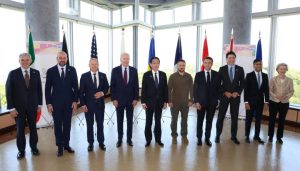Following conclusion of Hiroshima Summit, Part 6: Volodymyr Zelenskyy
May 29, 2023
“Surprise visit” draws attention from around the world, but A-bomb survivors remain anxious about Russia’s actions
by Michiko Tanaka, Senior Staff Writer
On the evening of May 21, after conclusion of the summit meeting of the G7 (Group of Seven industrialized nations), held in Hiroshima City, a crowd of people were lined up here and there along the roads from the area of Motoujina-machi (located in the city’s Minami Ward) all the way to Peace Memorial Park (in Naka Ward) to catch a glimpse of the president of war-torn Ukraine. Citizens waved their arms vigorously, expressing the sentiment that they “wanted to show support.”
Volodymyr Zelenskyy’s surprise visit to Hiroshima drew attention from around the world. As head of a country under the threat of nuclear weapons use by Russia, Mr. Zelenskyy toured the Hiroshima Peace Memorial Museum and met with Keiko Ogura, an 85-year-old A-bomb survivor. He wrote an entry in the museum’s guest book that read, “There is no place for nuclear threats in the modern world.” At a news conference held in the International Conference Center Hiroshima, he said, “We must eliminate war from the history of mankind.” His powerful words lent the appearance that he sympathized with the feelings of the A-bombed city.
“We were able to send out a message, with a sense of urgency, that we should never tolerate the threat of the use of nuclear weapons, let along their use,” Japan’s Prime Minister Fumio Kishida said, as he emphasized the significance of President Zelenskyy attending the meeting in person at a news conference marking the conclusion of the summit meeting.
Talks with national leaders
Mr. Zelenskyy obtained meaningful results through his act of taking on the risk of visiting Japan. As soon as he entered Hiroshima on May 20, he started separate talks with the leaders of each of the countries at the summit, including India Prime Minister Narendra Modi, who was invited to participate in the expanded G7 meeting. India, a representative of the emerging and developing countries described as the “Global South,” has avoided condemnation of Russia. Mr. Zelenskyy elicited a response from the prime minister that he would “do everything possible” to resolve the issue at the meeting.
Mr. Zelenskyy secured strong support from the G7 leaders, including U.S. President Joe Biden, who has approved of his European allies providing American-made F-16s to Ukraine. Mr. Zelenskyy took up a position almost at the center of a group photograph with the other G7 leaders, in a move designed to emphasize Russia’s isolation. It was a three-day period filled with the calculations of the different nations. After he laid flowers at the Cenotaph for the A-bomb Victims, which is inscribed with the vow never to wage war again, and called for support of his “dream of winning the war against Russia and achieving peace later,” Mr. Zelenskyy departed the A-bombed city.
No one knows what will happen in the future, but some fear that a cornered Russia might be provoked into further violence.
Shingo Naito, 84, an A-bomb survivor who lives in Hiroshima’s Minami Ward, said, “Of course, I pray for peace in Ukraine as soon as possible, but I cannot support even a war of self-defense.” He experienced World War II and lost his parents and siblings in the atomic bombing. “We have been calling for a world without war and nuclear weapons. Is there really no alternative in this case?”
Changing positions of Japan
That question will also be directed to the Japanese government, which served as chair of the Hiroshima Summit and accepted Mr. Zelenskyy’s visit with full knowledge of the risk. Some experts say that the government’s decision was aimed at deterring not only Russia but also China from “changing the status quo by force.” The media have reported that Mr. Kishida will attend the summit meeting of the North Atlantic Treaty Organization (NATO), the military alliance between the United States and Europe, in July following the G7 meeting in Hiroshima. If he does attend the meeting, it would be the second time and the second consecutive year for a Japanese prime minister to participate in a NATO summit.
The Hiroshima Summit highlighted the change in Japan’s positions due to the worsening security environment. Whether the A-bombed Hiroshima will be able to continue raising its voice with such sentiments as “No more nuclear weapons” and “No more war” is now called into question.
(Originally published on May 29, 2023)








